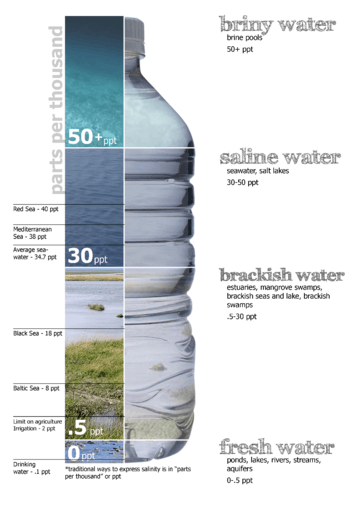List of bodies of water by salinity
| Part of a series on |
| Water salinity |
|---|
 |
| Salinity levels |
|
Fresh water (< 0.05%) Brackish water (0.05–3%) Saline water (3–5%) Brine (> 5%) |
| Bodies of water |
| Seawater • Salt lake • Hypersaline lake • Salt pan • Brine pool • Bodies by salinity |
This is a list of bodies of water by salinity that is limited to natural bodies of water that have a stable salinity above 0.5%, at or below which water is considered fresh. On average, seawater has a salinity of 3.5% (or 35 parts per thousand).
Water salinity often varies by location and season, particularly with hypersaline lakes in arid areas, so the salinity figures in the table below should be interpreted as an approximate indicator.
References
- ↑ G.M. Marion (1997). "A theoretical evaluation of mineral stability in Lolu Lake Pond, Nigeria, Victoria Land". Antarctic Science. 9 (1): 92–99. doi:10.1017/S0954102097000114.
- ↑ Perez, Eduardo; Chebude, Yonas (April 2017). "Chemical Analysis of Gaet’ale, a Hypersaline Pond in Danakil Depression (Ethiopia): New Record for the Most Saline Water Body on Earth". Aquatic Geochemistry. 23 (2): 109–117. doi:10.1007/s10498-017-9312-z.
- ↑ Goetz, P.W. (ed.) The New Encyclopædia Britannica (15th ed.). Vol. 3, p. 937. Chicago, 1986
- ↑ "Lake Urmia". Encyclopædia Britannica Online. 2012. Retrieved 28 August 2012.
- ↑ Can I float in Great Salt lake?. Utah Geological Survey.
- ↑ Little Manitou Lake. The Canadian Encyclopedia.
- ↑ "Frequently Asked Questions About Mono Lake". monolake.org. Retrieved 31 January 2015.
- ↑ "Ocean salinity". Science Learning Hub. Retrieved 2017-07-02.
- ↑ A. Anati, David (March 1999). "The salinity of hypersaline brines: Concepts and misconceptions". International Journal of Salt Lake Research. doi:10.1023/A:1009059827435. Retrieved 3 February 2016.
- ↑ The Biology and Culture of Tilapias: Proceedings of the International Center for Living Aquatic Resources Management, p.38
- ↑ "Atlantic Ocean". Encyclopædia Britannica. Retrieved 31 January 2015.
- ↑ "Beaufort Sea". Great Soviet Encyclopedia (in Russian).
- ↑ Indian Journal of Marine Sciences - Variation of Water Quality of Chilika Lake, Orissa
- ↑ Black Sea - Encyclopedia of Ukraine
- ↑ Yama, Tomonaga (22 March 2017). "Porewater salinity reveals past lake-level changes in Lake Van, the Earth’s largest soda lake". Scientific Reports. [[Nature (journal)|]] (7). doi:10.1038/s41598-017-00371-w.
- ↑ Lake Basin Management Initiative - The Caspian Sea (2004)
- ↑ Orlovsky, Leah; Matsrafi, Offir; Orlovsky, Nikolai; Kouznetsov, Michael (2014). "Sarykamysh Lake: Collector of Drainage Water – The Past, the Present, and the Future". The Turkmen Lake Altyn Asyr and Water Resources in Turkmenistan. Berlin/Heidelberg: Springer-Verlag. doi:10.1007/698_2012_191.
- ↑ Long Term Temperature & Salinity Records from the Baltic Sea Transition Zone
Notes
- ↑ Some bays have considerably lower salinity.
Bibliography
- Johanna Laybourn-Parry; Jemma L. Wadham (2014). Antarctic Lakes. Oxford University Press. pp. 92–94. ISBN 978-0-19-967049-9.
This article is issued from
Wikipedia.
The text is licensed under Creative Commons - Attribution - Sharealike.
Additional terms may apply for the media files.